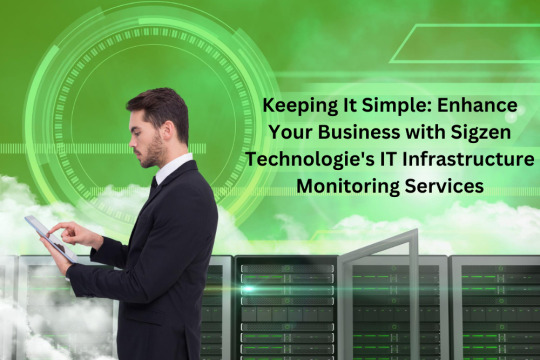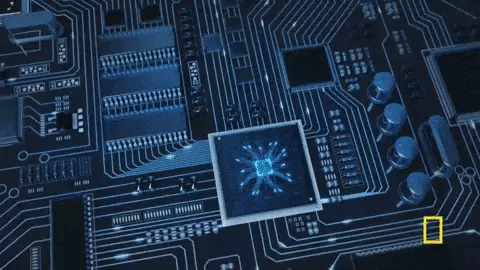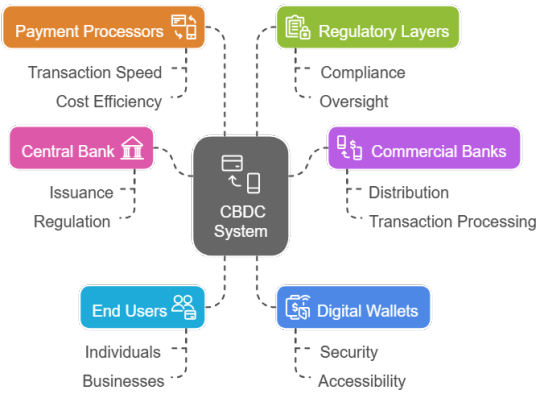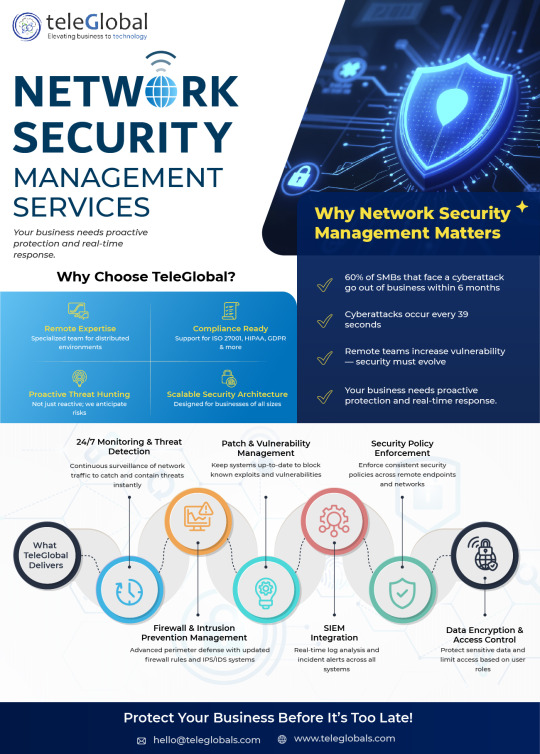#Infrastructure monitoring
Explore tagged Tumblr posts
Text
Optimize, Analyze, Adapt: The Three Pillars of Infrastructure Monitoring
Embrace a proactive approach to infrastructure management with our comprehensive monitoring solutions. By optimizing performance, analyzing data trends, and adapting to evolving needs, you can ensure the reliability, scalability, and agility of your IT infrastructure.
2 notes
·
View notes
Text
Key Advantages of Proactive Infrastructure Monitoring
In order to be able to operate effectively, modern businesses use digital systems, applications, and networks. A cloud-based platform or installation in the enterprise can be performed on premises and with literally hundreds of websites on the line, productivity, safety and customer satisfaction depend on efficiency. This is where infrastructure monitoring can be the most significant since it is the most useful when applied intelligently proactively rather than unintelligently defensively.
Being proactive in monitoring implies prevention of problems that may affect the user or crash the system. Instead of troubleshooting once complaints are received or when the system malfunctions, IT teams are able to think one step ahead using real time data, alerts and insights. Such a change in strategy provides a number of distinct benefits that can be called a wise move of any organization.

1. Reduced Downtime and Faster Recovery
Among the largest benefits of proactive monitoring lies the reduction of unexpected downtimes. Monitoring the performance metrics and behavior of the system causes them to notice warning signals such as memory leaks, excessive CPU utilization, or delayed response early so that they can be corrected before becoming severe. Should the failure be made, the data gathered leads to the identification of the main cause in a short period of time, which decreases the repairing time of the source.
This is of particular importance to those businesses which run on 24/7 services. Five minutes of outage would cause loss of income, reputation and customer dissatisfaction. Those risks are greatly diminished by proactive practices.
2. Improved Resource Utilization
Monitoring resource usage by servers, storage and network resources also prevents over-provisioning and under-provisioning. When the monitoring of systems is regular, it becomes simpler to identify the loaded resources and the idle ones. This enables the IT departments to balance out the workload, scale systems effectively and prevent wastage of funds on unnecessary hardware spending.
Decisions are made using real time and accurate data instead of resorting to assumptions. It means that it works more efficiently at reduced costs and utilizes fewer resources of a company.
3. Enhanced Security and Threat Detection
Although firewalls and antivirus tools are important, active monitoring will take your security strategy to the next level. It assists in identification of abnormal activity in the system, logins, or network, which may suggest a security compromise. The sooner such anomalous occurrences are detected the earlier teams get the time before serious damages are caused.
It comes in handy particularly in detecting gradual threats such as the insider abuse or stealth malware that are unlikely to raise early alerts. With the round-the-clock monitoring, companies will be able to develop a more robust security posture all together.
4. Better Planning and Forecasting
Regular tracking helps in giving quality historical information of the system performance and trends. This information serves as the basis of long-range planning as well as infrastructure development. IT leaders are able to detect trends in system loads, seasonal traffic peaks or increasing storage capacity and plan in advance.
Instead of responding to immediate needs or unpredictable performance problems, companies will be able to predict needs with security and get in front of the increase.
5. Increased Customer Satisfaction
Customers or internal organizational units are end users. They are the ones that want to have a fast and reliable digital experience. Trust and satisfaction are created when services are constantly accessible and responsive. Active supervision makes sure that those artefacts that may hamper the user experience are corrected prior to them developing.
Continuity and the flawless work of the infrastructure will decrease an amount of complaints, enhance production, and enlarge the whole interaction. It also saves the support teams the hassle of working on service tickets all the time because of avoidable work.
Conclusion
Active infrastructure monitoring gives business possibilities to be ahead of issues, make best resource usage, and be able to perform more widely. Rather than responding to crises, organizations get control, agility, and confidence in their digital activities. Combining proactive tools and strategies, businesses can defend their systems, improve customer experience, cut costs and develop long- term reliability in their operations. Monitoring infrastructure is no longer optional in the modern high-tempo digital world; rather, a strong monitoring infrastructure foundation is a competitive advantage.
0 notes
Text
Trends in the IT Infrastructure Monitoring Tools Market
In today’s digital-first world, the role of IT infrastructure has never been more critical. Organizations across industries rely on complex and distributed IT systems to run their operations, deliver services, and drive innovation. As the demands on these systems grow, so too does the need for robust, intelligent, and scalable monitoring solutions. Enter the new era of IT Infrastructure…

View On WordPress
#AI in ITIM#business#Business Intelligence#Information Technology#infrastructure#infrastructure monitoring#infrastructure observability#IT Infrastructure#IT infrastructure monitoring#IT infrastructure monitoring tools#IT monitoring automation#it monitoring systems#it network monitoring#ITIM tools
0 notes
Text
What is INSAR Slope Monitoring and Why Is It Important for Geotechnical Engineering?
Monitoring slopes and detecting ground movements are important for ensuring the stability of different structures like dams roads and buildings especially in areas prone to landslides or even earthquakes. One of the most advanced technologies for monitoring slope movements is Insar Slope Monitoring. In this guide you can learn everything about it's important in the field of geotechnical engineering.
What do you need to know about the slope monitoring?
Just like infrastructure monitoring slope monitoring is actually a remote sensing technology that uses radar signals to detect and measure ground movements. The method includes the use of satellite based radar to capture images of the surface of the earth with time. By comparing all these images it's really possible for you to detect even tiny changes in the position of the ground. The satellite works by sending radar waves from a satellite to the Earth's surface and then measuring the time it takes for these waves to bounce back to the satellite. When these measurements are compared across multiple radar images you can create a detailed map of surface movement.
Why is this monitoring important?
One of the most important risks associated with slopes especially in mountainous or hilly areas is the potential for landslides. This can cause major damage to infrastructure disrupt communities and even result in loss of life. The slope monitoring provides you early warning signs by detecting ground movements long before a landslide occurs.
Well you need to know that the slope monitoring is an invaluable tool in geotechnical engineering providing accurate real time data on slope movements and helping you prevent disasters caused by landslides or slope failures.
0 notes
Text
I saw a post on Facebook that cited a single tweet from a person with seemingly no public health or epidemiology credentials as proof that H5N1 is about to be 1918 flu epidemic, part deux, and made a number of easily disprovable, google-able claims about the mortality rate of the currently spreading strains among humans.
And when someone commented that the tone seemed pretty alarmist and unhelpful. Someone else replied "WELL, IF YOU'RE SCARED IMAGINE HOW SCARED DISABLED PEOPLE ARE."
And. Okay. Well. I am worried. To the extent that disabled people can be considered a monolith, many disabled people are worried.
Please explain to me how spreading misinformation on Facebook helps anyone?
The internet was a mistake.
#yes it's quite concerning#yes it's important to monitor#ideally it's important to beef up our state and local infrastructure and our community response#it's important to protect ourselves and each other#HOWEVER#the internet was a mistake#h5n1
6 notes
·
View notes
Text
IT Infrastructure Monitoring
In the fast-paced world of technology, the backbone of any successful business lies in its IT Infrastructure monitoring.

View On WordPress
#Infrastructure Monitoring Tips#it#IT Infrastructure Monitoring#Monitoring Solutions#Monitoring Techniques#Revolutionizing IT Monitoring#Sigzen Technologies#technology
3 notes
·
View notes
Text
Exploring the Diverse Landscape of Surveys: Unveiling Different Types
Introduction Civil engineering, as a discipline, relies heavily on accurate and comprehensive data to design, plan, and construct various infrastructure projects. Surveys play a crucial role in gathering this essential information, providing engineers with the data needed to make informed decisions. There are several types of surveys in civil engineering, each serving a unique purpose. In this…

View On WordPress
#accurate measurements#as-built survey#boundary survey#civil engineering data#Civil engineering surveys#construction progress monitoring#construction survey#design accuracy#environmental monitoring#geodetic survey#global mapping#hydrographic survey#infrastructure development#infrastructure projects#land surveyor#legal boundaries#monitoring survey#project planning#property lines#structural integrity assessment#surveying in civil engineering#surveying innovations#surveying technology#topographic surveying#water body survey
2 notes
·
View notes
Text
Complexity Monitoring Device for Local Anomaly Detection in Networks
The blog provides a brief description of a Quantitative Complexity Management-based (QCM) network monitoring device. The QCM technology has been under development by Ontonix since 2005. Numerous applications have been developed which span various sectors of the industry, economics, finance and medicine. In the majority of cases, QCM solutions are used for following…

View On WordPress
#Complexity#complexity management#critical infrastructures#Extreme problems#fragility#infrastructure protection#networks#resilience#system monitoring#system of systems#vulnerability
2 notes
·
View notes
Text
What Is Infrastructure Monitoring and Why Is It Essential?
Most businesses now depend on technology to function well. IT infrastructure is key to everything happening with customer data, the use of websites and running internal systems. That’s the reason why checking infrastructure is so important. So, what is success and just why is it so important?

Defining Infrastructure Monitoring
Infrastructure monitoring involves watching and analyzing the main systems in your technology network which include servers, networks, storage, databases and applications. This is done to guarantee that the business runs smoothly and correctly.
Thanks to specific instruments, IT teams can monitor CPU use, the amount of RAM needed, network traffic and data on disks. Thanks to this, they are able to spot and fix faults before they disturb users or and business activities.
Why Is It Important?
Let’s face it: if something breaks in your IT setup, it can cause delays, customer dissatisfaction, and even financial loss. Here’s why infrastructure monitoring should be a top priority:
1. Prevents Downtime
Should a server crash or the internet connection slow down, the business will feel it right away. When you monitor systems, you see any rising temperatures or growing memory use, helping you to fix problems before anything breaks down.
2. Improves Efficiency
Observing the use of resources can show a firm where its productivity is falling behind. It’s possible that some servers are handling most of the work, whereas others are left almost idle. Infrastructure monitoring uncovers where resources are misused, giving IT teams a chance to improve the whole system.
3. Supports Growth
With its expansion, the company’s IT needs change, too. With the data kept in monitoring tools, it’s possible to see patterns that help decide on upgrading storage space, servers or bandwidth in the future. You can identify needed upgrades and ensure you don’t add too much work to what you already have.
4. Enhances Security
It increases the safety from cyber threats. When access attempts are not allowed, traffic is uncommon or the company’s data usage rises suddenly, a security incident may have occurred. Sooner you identify a risk, the sooner you can deal with it and the less danger involved.
5. Better Troubleshooting
Whenever there is a problem, finding what caused it quickly is very important. If teams proactively monitor issues, they can solve any problem—hardware, settings or network changes—quickly.
What Makes a Good Monitoring Setup?
The best infrastructure monitoring tool should send alerts as soon as something is wrong, allow users to set their own dashboards and provide additional reports. Your system should be able to expand when your business grows. Today’s companies with hybrid IT setups appreciate it when their servers are also cloud-compatible.
Modern tools often come with automation which means you don’t have to manually start a server without warning if a system issue occurs.
Final Thoughts
Simply put, anyone using technology in their business must make infrastructure monitoring a priority. Monitoring means you can keep an eye on all your systems, make sure all is running smoothly and resolve conflicts before they become serious. Investing in the right monitoring software can save both small companies and bigger businesses both stress and additional costs.
0 notes
Text

Letter campaign
write your reps pressing for wastewater data to be funded and promoted.
1 note
·
View note
Text
MeshTek’s Smart IoT Framework: Building the Future of Connected Systems

MeshTek’s advanced IoT development service in action — where powerful software meets real-time automation. From smart connectivity to integrated mesh-based communication, the setup represents how businesses can monitor, manage, and optimize connected devices through a seamless, intelligent platform. The background workspace and digital overlays highlight MeshTek’s vision for scalable, secure, and low-latency IoT ecosystems designed for the modern world.
#MeshTek#IoT development service#Bluetooth mesh IoT#connected devices#smart automation#real-time IoT monitoring#low-latency communication#industrial IoT platform#smart infrastructure#scalable IoT systems#IoT software development#next-gen connectivity#AI-powered IoT#secure IoT network#edge computing solutions#smart business automation#intelligent IoT services#future-ready technology#MeshTek solutions#IoT mesh technology
0 notes
Text

Explore the top 10 best practices to ensure scalability in cloud computing with eShare.ai. From choosing the right architecture and load balancing strategies to monitoring usage and automating deployments, these principles help businesses maximize performance, reduce downtime, and scale seamlessly. Perfect for startups and enterprises aiming for efficiency in a digital-first world.
#cloud scalability#cloud computing best practices#eShare.ai#scalable cloud infrastructure#SaaS optimization#business cloud strategy#scalable architecture#load balancing cloud#cloud automation#IT infrastructure#performance monitoring#enterprise cloud solutions
0 notes
Text
CBDC technology partner India

As CBDCs become a global reality, Prodevans equips banks with everything needed to enter the digital currency ecosystem. We provide full-spectrum CBDC implementation — including compliant architecture, token management, real-time reconciliation, secure wallet enablement, and 24/7 L1/L2 support. Trusted for our role in India’s national rollout, we help institutions go beyond pilots to scalable, production-ready platforms ensuring seamless end- user readiness. Our services ensure central bank compliance while delivering performance, observability, and rapid response to evolving regulatory needs. Whether you’re in the pilot phase or preparing for production rollout, Prodevans supports your CBDC journey at every step.
OUR ADDRESS
403, 4TH FLOOR, SAKET CALLIPOLIS, Rainbow Drive, Sarjapur Road, Varthurhobli East Taluk, Doddakannelli, Bengaluru Karnataka 560035
OUR CONTACTS
+91 97044 56015
#CBDC (Central Bank Digital Currency)#Cloud Computing & Cloud Services#Application Modernization#360° Monitoring (Server#Application#Database & Virtualization Monitoring)#Identity & Access Management (IAM)#Automation (incl. ML‑driven#Ansible#network/cloud automation)#DevOps Tools & Support#Infrastructure Management (IaaS/PaaS/SaaS#orchestration#orchestration tools)
0 notes
Text
CEO Found Out Website Was Down via WhatsApp | Website Maintenance Company in Qatar
In 2023, a company’s site went down all weekend. No alerts. No one noticed. The CEO only found out when a client WhatsApped him Sunday morning. That’s what happens when you don’t monitor. We fix that.
Want real-time site monitoring with zero guesswork? Visit: Website Maintenance Company in Qatar
#website maintenance#web maintenance qatar#website downtime story#site monitoring fail#how to monitor uptime#real time server alerts#business tech mistake#website error 500#hosting fail story#devops fail case#digital forge monitoring#lost leads downtime#server health check#uptime log system#ceo client fail#web infrastructure mistake#web design company Qatar#web design agency Qatar#digital forge#qatar#doha#digital marketing agency qatar#digital marketing agency
0 notes
Text

Network Management Services in Pune | Teleglobal
Empower Your Network for Efficient Performance From network setup and monitoring to firewalls and load balancer setup, we offer a secure, optimized, and high-performing network infrastructure. Our Network Management Services provides end-to-end solutions that boost network security, performance, and reliability, ensuring nothing interrupts connectivity of your business.
Optimize Your Network Today https://teleglobals.com/contact-us
#Network Management Services#Network Management#IT Infrastructure#Remote Monitoring#IT Support#Managed Services#Tech solutions#Digital Transformation#Cloud Computing#Cyber Security#Business Continuity
0 notes
Text
Smart Practices for Infrastructure Monitoring Success
With technology evolving every day, businesses require strong, reliable infrastructure to run its operations. Website, internal system, and cloud application functionality rely on constant performance. That is the very reason why infrastructure monitoring is important. To measure the health, performance, use of IT assets, businesses can reduce the disruption of operations, enhance product generation, and prevent risk from turning into crises. As companies find themselves in ever more complex IT landscapes, infrastructure monitoring is critical for efficient proactive management.

Here are the key smart practices for effective infrastructure monitoring:
Define Clear Monitoring Goals
Set clear objectives first and then you are in a position to pick the right monitoring tools. What systems or applications do you have the largest effect on your organization’s operations? Do you need to evaluate system availability, response speed of service, or amount of mistakes made? Clarifying your KPIs provide you with direction into important metrics that also minimizes the chances of feeling overwhelmed by too much data.
Choose a Centralized Monitoring Solution
A centralized monitoring platform is an integration of performance data of servers, applications, databases and networks for quick retrieval. By consolidating monitoring, IT staff can identify recurring trends, connect troubles across varied systems and reduce the response lag on incidents.
Set Up Real-Time Alerts
Real-time alerting is crucial for catching problems as they happen. Configure threshold-based alerts for CPU usage, memory, disk space, and network traffic. Use escalation policies so that critical alerts are prioritized and sent to the right team members without delay.
Monitor Continuously, 24/7
Your IT systems operate around the clock—your monitoring should, too. Continuous monitoring ensures that issues are caught anytime, day or night, preventing after-hours outages from turning into costly downtime.
Track and Analyze Historical Data
Historical metrics are invaluable for trend analysis. By examining past performance data, you can identify recurring issues, plan capacity upgrades, and make informed decisions on infrastructure scaling.
Leverage Automation Wherever Possible
Automate routine monitoring tasks such as log collection, health checks, and system scans. Automation saves time, reduces manual errors, and ensures consistency across your monitoring process.
Prioritize Security in Monitoring
Infrastructure monitoring tools collect sensitive information. Secure them with role-based access controls, strong authentication, and encrypted data storage. This not only protects data but also maintains compliance with security regulations.
Regularly Review and Optimize Monitoring Strategies
As your infrastructure evolves, so should your monitoring strategy. Periodically review metrics, update thresholds, and integrate monitoring with other IT service management (ITSM) tools. This helps keep your monitoring setup aligned with business growth and technical requirements.
Ensure Scalability for Future Growth
Your monitoring system should grow with your infrastructure. Choose tools and configurations that can handle expanding workloads, cloud migrations, and hybrid environments without sacrificing visibility or performance.
Integrate with Incident Management Tools
Link monitoring tools with service desks, ticketing systems, or incident response platforms to streamline workflows. This ensures quick resolution and better coordination among IT teams.
Conclusion
Adopting smart practices for infrastructure monitoring enables businesses to detect issues early, minimize downtime, and optimize system performance. In the middle of your IT operations, infrastructure monitoring is key to creating a resilient and efficient technology environment.
0 notes